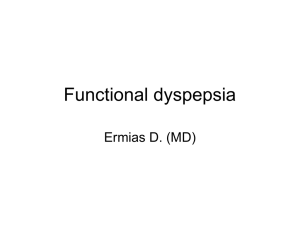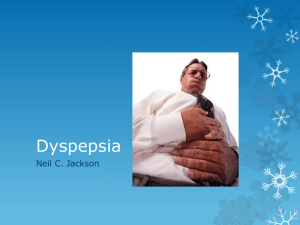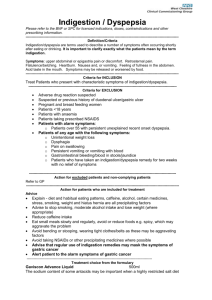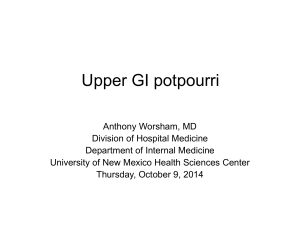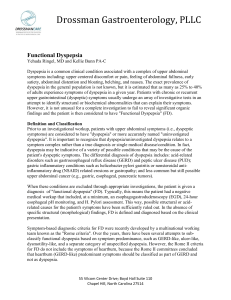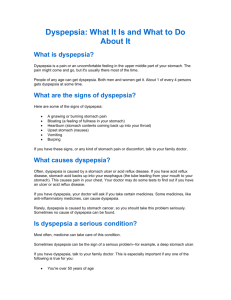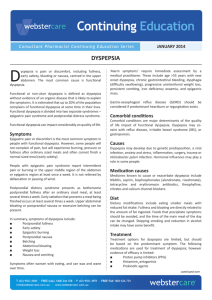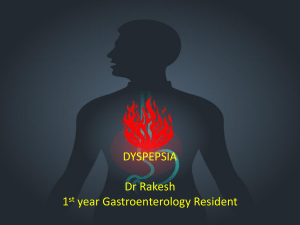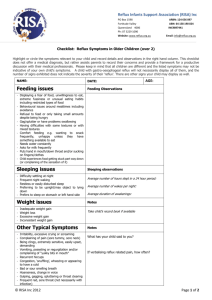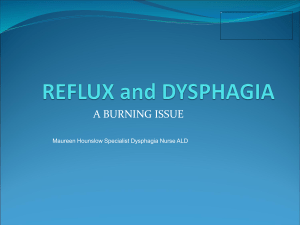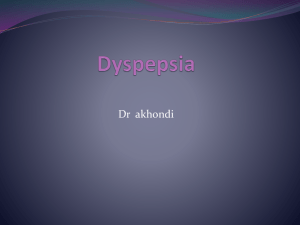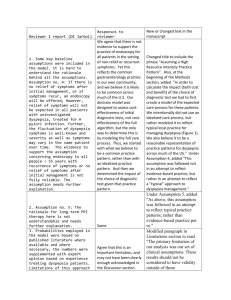Dyspepsia - UBC Wiki
advertisement
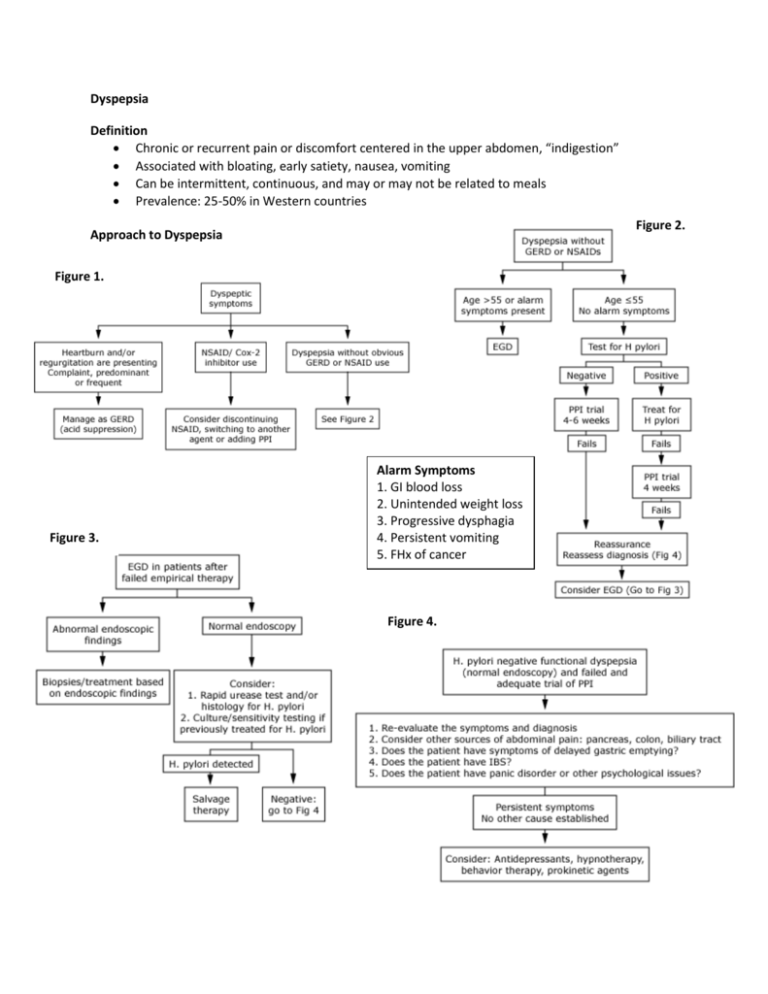
Dyspepsia Definition Chronic or recurrent pain or discomfort centered in the upper abdomen, “indigestion” Associated with bloating, early satiety, nausea, vomiting Can be intermittent, continuous, and may or may not be related to meals Prevalence: 25-50% in Western countries Figure 2. Approach to Dyspepsia Figure 1. Figure 3. Alarm Symptoms 1. GI blood loss 2. Unintended weight loss 3. Progressive dysphagia 4. Persistent vomiting 5. FHx of cancer Figure 4. Differential Diagnoses (Table 2, AFP) Functional (idiopathic, non-ulcer) (up to 70%) Peptic ulcer disease (gastroduodenal) (15-25%) Reflux esophagitis (5-15%) Gastric or esophageal cancer (<2%) Other differential diagnoses are rare: Abdominal cancer (esp pancreatic) Biliary tract disease CHO malabsorption Gastroparesis Hepatoma, etc. Risk Factors Medications: ASA, NSAIDs (Table 3, AFP) EtOH and tobacco are potential triggers Emotional stress frequently associated with functional dyspepsia Gastroesophageal Reflux Disease Most common condition to affect the esophagus Can range from heartburn with endoscopy-negative reflux disease to ulcers, stricture, Barrett's Everyone has some degree of GE reflux → Pathological when there are sx + complications Pathophysiology Reflux of gastric contents into the esophagus, can occur with and without hiatus hernia Factors: LES function, intra-abdominal pressure Peristalsis, salivation, Mucosal defense Clinical Features Heartburn, acid regurgitation after eating certain foods or following various postural maneuvers Waterbrash, angina-like chest pain, dysphagia, respiratory symptoms, odynophagia rare Common in pregnancy (↑intra-abdominal pressure and LES relaxant effect of progesterone) If severe, stricture formation → wt loss (↓intake) Aspiration: consolidation, bronchospasm, fibrosis Diagnosis mostly via history and physical Investigations reserved to answer following: Amount of reflux abnormal? Symptoms due to reflux? Mucosal damage or other complications? Patients with long-standing GERD → endoscopy 5-10% will have Barrett's (if > 5y of symptoms) If young, typical and infrequent symptoms → empiric therapy Treatment Lifestyle Modifications Elevate head of bed, Quit smoking, Avoid recumbency for 3h after eating Avoid trigger foods/drinks, Losing weight Acid suppression: antacids, alginates, H2RA, PPI Refractory Symptoms → endoscopy Pregnancy: antacids, alginates, cimetidine Oral Acid Suppressants Helicobacter pylori Infection Most common gastric bacterial infection worldwide, Prevalence: 20-30% in Western world Most H. pylori-infected individuals have associated gastritis, although many have no symptoms Associated with increasing risk of PUD, gastric cancer, gastric MALT lymphoma Antral gastritis → atrophic gastritis + intestinal metaplasia → gastric cancer Risk factors: Immigration from a developing country, low SES, family overcrowding Testing * Serology: unable to differentiate active from past infection. Will remain positive for several years following successful treatment. ** UBT, endoscopic gastric biopsy, fecal antigen testing may be affected by medications such as antibiotics and acid lowering agents → hold bismuth and antibiotics x 28d and PPI for 7-14d prior to testing. H. pylori Eradication Small but statistically significant improvement in functional dyspepsia symptoms Decreases risk of PUD and its complications NNT=15 for relief of symptoms Cost-effectiveness unknown Prokinetics for Functional Dyspepsia Target patients with predominant symptoms of bloating, early satiation, nausea, and vomiting Aim: improve GI motility Domperidone, metoclopramide, erythromycin, peppermint Evidence poor CCFP Objective #1 In a patient presenting with dyspepsia, include cardiovascular disease in the differential diagnosis. CCFP Objective #2 Attempt to differentiate, by history and physical examination, between conditions presenting with dyspepsia (e.g., gastroesophageal reflux disease, gastritis, ulcer, cancer), as plans for investigation and management may be very different. CCFP Objective #3 In a patient presenting with dyspepsia, ask about and examine the patient for worrisome signs/symptoms (e.g., gastrointestinal bleeding, weight loss, dysphagia). Resources Loyd, RA et al. Update on the evaluation and management of functional dyspepsia. Am Fam Physician. 2011; 83(5): 547-552. First Principles of Gastroenterology Uptodate: Approach to patient with dyspepsia McMaster Module on Dyspepsia BC Guidelines: Dyspepsia, GERD
